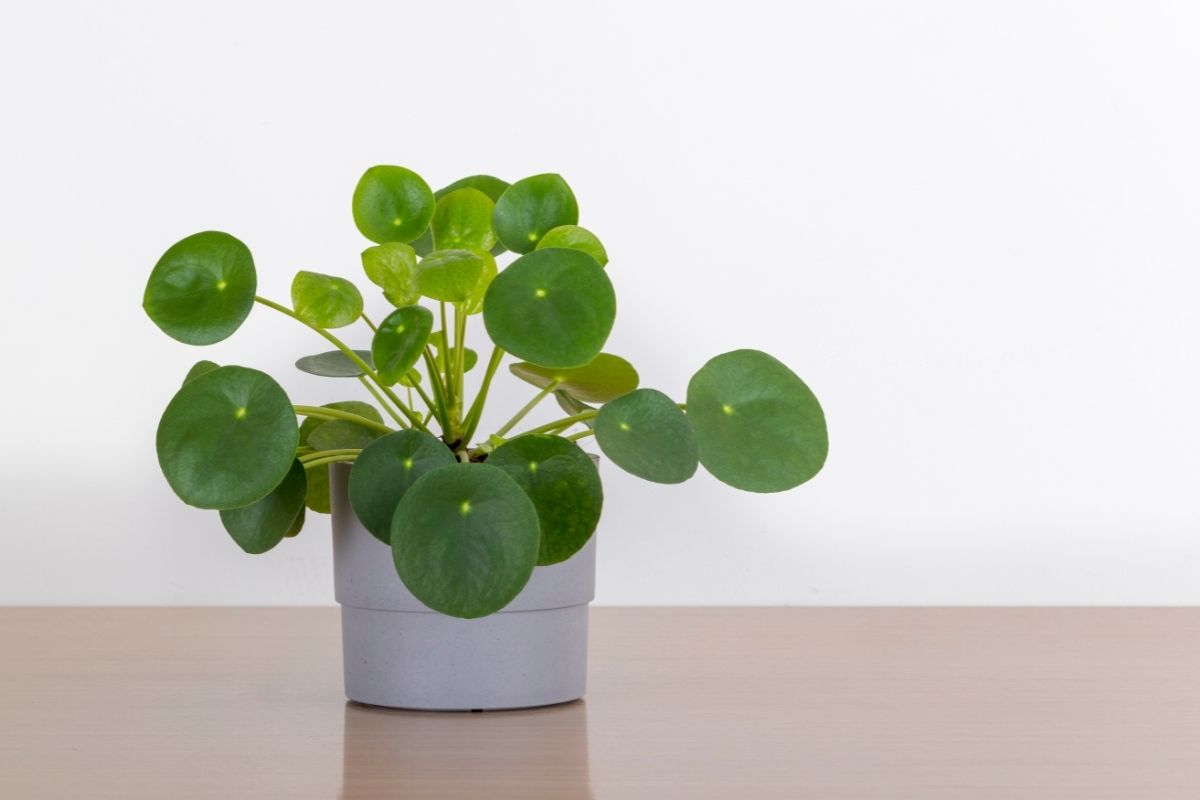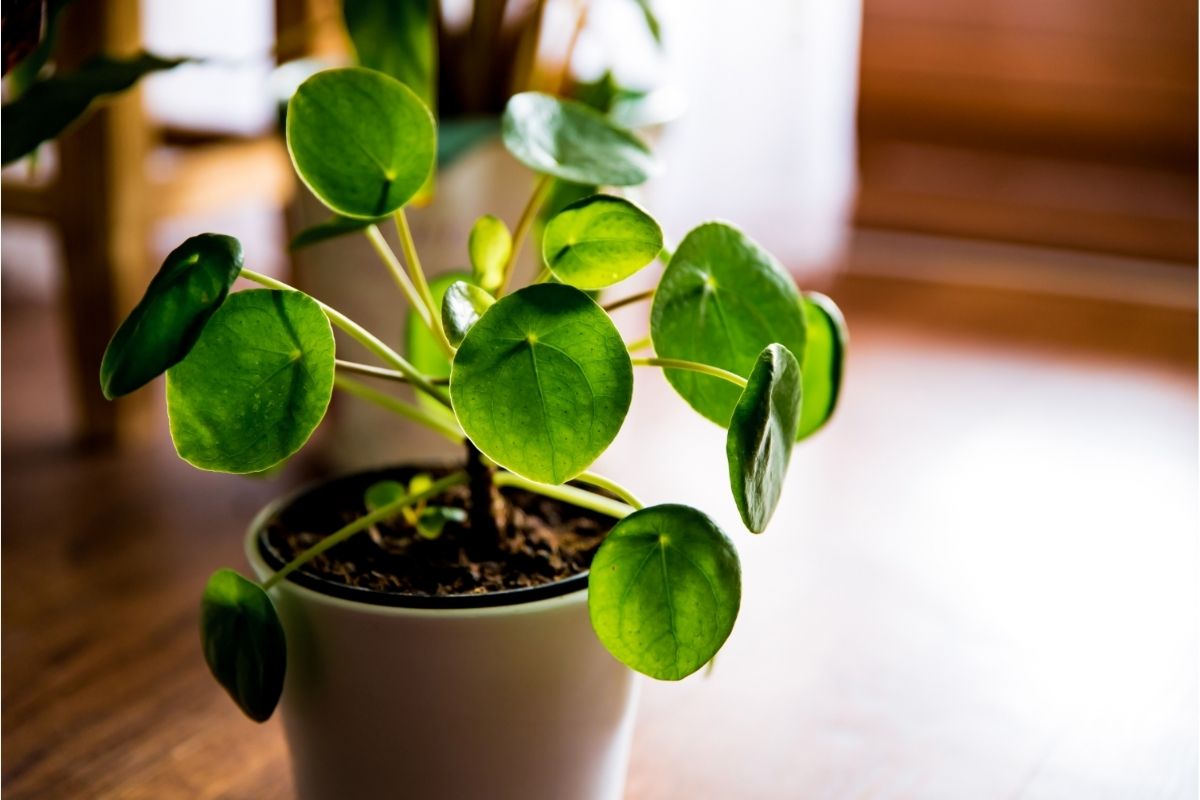A Pilea plant is a stunning plant with large green leaves, that are shaped very similarly to coins – which is why the Pilea is more commonly known as the Chinese Money Plant!
It is perfect at thriving in dry and darker conditions, and its low-maintenance nature makes it brilliant for people who aren’t as invested in nurturing a plant every day.
Because of this, the Pilea plant is highly sought after. To make things easier, it is very easy to propagate to create new plants! Carry on reading to find out how you can successfully propagate a Pilea plant.

Pilea Propagation In Water
The first method you can use to propagate your Pilea plant is by leaving the cutting’s roots to develop in water.
This is the faster of the two methods, and it is much easier to see the progress your Pilea is making using this method.
1. First, get yourself a pair of scissors or a paring knife. A paring knife is a very useful tool. However, you should always make sure to sanitize any tools you are planning on using before you cut your plant.
This is because you don’t want to risk transferring any infections or diseases to your baby Pilea!
2. You can use the paring knife to cut off a piece of a leaf, but you also need to make sure that there is a small part of the stem or trunk connected to it.
Cutting off a leaf without cutting off any part of the stem or branch is impossible.
3. A petiole is a thin stalk that connects two leaves together. Cutting a petiole off prevents the plant from growing new leaves.
4. Make sure that you use a healthy leaf. Don’t use a leaf that has yellowed, has fallen off by itself, or appears limp or weak.
This increases your chance of failure. Also bear in mind that you should always do multiple cuts because you never know which one will actually take and proceed into rooting.
5. Be careful when you cut into a tree trunk, don’t go too deep where you’ll weaken it.
You can propagate that by cutting the trunk into several pieces, but be sure to leave some original trunk intact.
6. Now you will need to place your cuttings in clean water. This should be in a clear container, which allows you to keep track of how the roots are developing.
RELATED: Moss In Lawn? Is It Harmful, And How To Get Rid Of It For Good?
How Long Should You Leave The Cutting In Water?
1. Wait until the roots are about an inch long before planting them into the soil. This allows the root system time to grow and develop.
2. Be sure to change the water every week. Clean the vessels often. Keep the pots clean and slime free. After two months, you should see new plants growing.
3. Cuttings should be kept in a dark room until roots form. They should be placed in a bright location where sunlight is available. Once roots form, they should be moved to a sunny spot.
Pilea Propagation In Soil
Propagating your plants is a good way to get new healthy plants for yourself! You should know how to plant seeds, cuttings, or leaves.
All of these methods are pretty much the same, but there are slight differences. Follow the instructions carefully below to propagate your Pilea using soil.
1. First off, begin by checking whether your offshoots are prepared to be cut.
Despite being hardy plants, you should select a baby plant that is about two to three inches (five to seven centimeters) tall before you cut them.
2. When the baby plant is of an ideal size, you can proceed. Start by pulling the parent Pilea out of its pot.
Hold the hard stems towards the bottom of the Pilea, and tip the pot towards the ground. Gently pull out the plant so that the entire root system comes out.
3. Carefully dig out the baby flower and locate the point of convergent roots of the two flowers. Cut the root at the convergence without damaging the rest of the flower.
Remember not to damage the flower or root in any case!
4. Remove the excess dirt by shaking the plant off. Put the plant into a new pot and fill it up with soil. Don’t let the soil dry out. Add some fertilizer to the soil. Keep the soil moist.
5. A new plant should be given about a month to settle down after repotting. Repotting is done during spring as the growing period helps the plant to get used to the new place.
After all the steps are completed you basically get a new plant. You now have two cute little Pili plants!
Things To Remember When You Propagate Your Pilea:

1. Cuttings should be taken in spring!
2. Baby plants grow out of the mother plant, but they’re too young to be useful yet. Wait a few weeks until they’re bigger before you take them off the mother plant.
3. When propagating Pilea, you must put them in water first, because they do not have roots yet. You need to change the water often, and be patient as it may take up to one month before you see roots grow.
4. Once you see enough roots growing, you can pot the baby plantlet in some soil; fill your pot with a mixture made of perlite and soil.
Use an all-purpose or tropical soil mixture, but make sure it has a good drainage system.
5. Put Pilea in a pot with drainage holes at the bottom. While the Pilea needs to be watered every day, you need to be cautious about how much water you use.
Overwatering makes plants suffer, and it can also lead to unnecessary diseases, so be careful when watering.
6. Pilea loves bright, direct light. Remember to use shades or curtains if facing south or west. Rotate your plant periodically to keep it looking nice and symmetrical.
7. Baby plants need time to establish themselves in the ground. During this period, they may not be visible or even noticeable.
Once established, they will continue to grow.
8. Plants grow when they feel happy and comfortable. When they get enough sunlight, they produce more seeds.
Once they get enough water, they produce more roots. And once they get enough nutrients, they produce more leaves.
RELATED: How To Get Rid Of Moss In Your Lawn Naturally | Expert Tips & Tricks
To Sum Up…
There are two methods to easily propagate a Pilea plant.
This is by placing a cutting from a mature Pilea plant in water and leaving the roots to develop, or by placing an offshoot from a mature plant into soil and leaving it to develop its own (already present) root system.
While the water method is faster, the soil method takes a lot less maintenance. However, you won’t be able to keep track of how the roots are developing if you are propagating the Pilea in soil.
Frequently Asked Questions:
What Is The Difference Between A Seedling And A Potted Plant?
Seedlings are small plants that have just been planted in their pots. They usually don’t have any roots. A potted plant already has a root system.
What Happens If The Propagated Pilea Doesn’t Grow Any Roots?
A baby plant needs to be planted in the soil before it starts growing roots. Roots are needed to help plants get nutrients from the ground.
Plants without roots won’t survive very long, as they won’t be able to absorb water or food well without them!
How Do I Know If My Pilea Is Ready For Transplanting?
You can tell if your Pilea is ready to be transplanted by checking whether there are any signs of roots on the stem. If there aren’t any roots, then you should wait another week.
If there are roots, then you should start preparing your container for planting.







